
Google’s Salesforce Instances Hacked in Ongoing Attack: Hackers Exfiltrate User Data
Google’s Salesforce Breach: A Deep Dive into the UNC6040 Attack
In an alarming development for cloud security, Google has confirmed that one of its corporate Salesforce instances was compromised in June by the sophisticated threat group tracked as UNC6040. This incident is not isolated but part of a broader, ongoing Salesforce attack campaign that leverages insidious voice phishing techniques to steal sensitive organizational data, culminating in aggressive extortion demands. The breach at a tech giant like Google underscores the escalating risks associated with social engineering and highlights the critical need for robust defense mechanisms in cloud environments.
The Anatomy of the Attack: UNC6040 and Voice Phishing
The attackers, identified as UNC6040, employed voice phishing (vishing) as their primary vector. This technique involves manipulating individuals over the phone to divulge confidential information or perform actions that compromise security. In the context of Salesforce, this could entail tricking employees into revealing login credentials, approving multi-factor authentication (MFA) prompts, or installing malicious software.
Once initial access is gained, UNC6040 focuses on exfiltrating user data from the compromised Salesforce environments. This data, which can range from customer information to proprietary business intelligence, then becomes leverage for extortion. The double whammy of data theft and subsequent blackmail presents a significant operational and reputational risk to affected organizations.
Why Salesforce Instances Are Prime Targets
Salesforce, as a leading Customer Relationship Management (CRM) platform, holds a vast amount of sensitive customer data and critical business processes. Its widespread adoption across enterprises makes it an attractive target for threat actors. A successful breach of a Salesforce instance can grant attackers access to:
- Customer personally identifiable information (PII)
- Sales forecasts and strategies
- Employee data
- Proprietary business documentation
The interconnected nature of cloud platforms means that a breach in one service, even a third-party one like Salesforce, can have ripple effects across an organization’s entire digital ecosystem.
Broader Implications for Cloud Security
The Google breach serves as a stark reminder that even organizations with advanced security capabilities are vulnerable to sophisticated social engineering attacks. It emphasizes that no single security measure is foolproof, and a layered defense approach is paramount. The incident also highlights the evolving threat landscape, where attackers are increasingly targeting the human element, rather than solely relying on technical vulnerabilities in software or systems.
Remediation Actions and Prevention Strategies
In light of this incident and the ongoing vishing campaigns targeting Salesforce, organizations must take proactive steps to harden their defenses:
- Enhanced Employee Training: Conduct regular and sophisticated security awareness training that specifically addresses voice phishing techniques. Educate employees on how to identify suspicious calls, verify caller identities, and report potential vishing attempts.
- Stronger Authentication Controls: Implement and enforce strong multi-factor authentication (MFA) for all Salesforce users. Consider FIDO2/WebAuthn hardware tokens for the highest level of phishing resistance.
- Principle of Least Privilege: Ensure that users only have the minimum necessary access privileges within Salesforce environments. Regularly review and revoke unnecessary permissions.
- API Security and Monitoring: Closely monitor API access and integrations with Salesforce. Implement robust API authentication, authorization, and rate limiting to prevent automated data exfiltration.
- Regular Security Audits: Conduct frequent security audits and penetration testing of your Salesforce configurations and integrated applications.
- Incident Response Plan: Develop and regularly test a comprehensive incident response plan specifically for cloud service breaches, including Salesforce. This plan should detail steps for detection, containment, eradication, recovery, and post-incident analysis.
- Vendor Security Assessment: Continuously assess the security posture of third-party cloud vendors like Salesforce. Understand their security controls, incident response capabilities, and data breach notification policies.
Relevant Tools for Detection and Mitigation
Implementing the right tools can significantly enhance an organization’s ability to detect and mitigate social engineering attacks and data exfiltration attempts from platforms like Salesforce.
| Tool Name | Purpose | Link |
|---|---|---|
| Salesforce Shield | Platform encryption, event monitoring, and field audit trail for enhanced data security and compliance. | https://www.salesforce.com/products/platform/shield/ |
| Security Information and Event Management (SIEM) | Aggregates and analyzes security logs from various sources, including Salesforce, for anomaly detection and threat intelligence. Examples: Splunk, Microsoft Sentinel. | https://www.splunk.com/en_us/products/platform/security-information-event-management-siem.html |
| Cloud Access Security Broker (CASB) | Enforces security policies for cloud usage, detects shadow IT, and identifies data exfiltration. Examples: Palo Alto Networks Prisma Access, Netskope. | https://www.paloaltonetworks.com/cloud-security/prisma-access |
| User and Entity Behavior Analytics (UEBA) | Identifies anomalous user behavior that may indicate a compromised account or insider threat. Often integrated into SIEM or CASB solutions. | https://www.gartner.com/en/information-technology/glossary/user-and-entity-behavior-analytics-ueba |
Conclusion
The UNC6040 attack on Google’s Salesforce instance serves as a critical wake-up call for every organization leveraging cloud services. It underscores the sophisticated nature of modern cyber threats, particularly those employing social engineering. Protecting sensitive data in a cloud-first world demands a multi-faceted approach that combines advanced technical controls with robust human-centric security awareness. Proactive vigilance, continuous monitoring, and employee education are no longer optional; they are foundational to maintaining a secure digital posture against ever-evolving adversaries.





